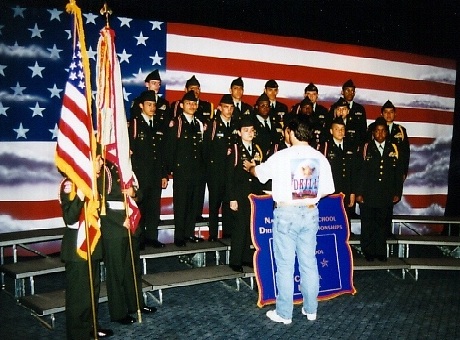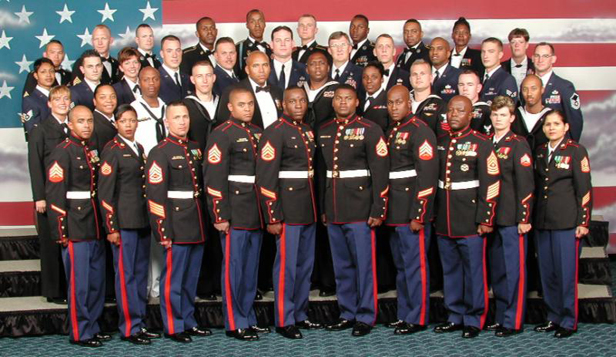regarding
Sports Network International
JROTC Drill Competitions
 1. PURPOSE
1. PURPOSE - To identify potential safety hazards/risks to cadets, instructors and spectators that are possible during the upcoming military championship event.
- To itemize the areas of hazard/risk that are handled by SNI both on-site and in advance.
- To pose mitigation/elimination methods to give everyone the best chance of staying safe throughout the weekend.
2. DRILL WORLD OVERVIEW
With the world situation changing forever in the Fall of 2001, Sports Network International immediately took great effort to evaluate the overall safety factor of every youth competition we host throughout the United States. This top-to-bottom evaluation included both internal review of safety considerations for all attendees at and around SNI events, as well as getting external input from security experts in the field regarding all facets of these tremendously exciting and beneficial competitions.
The first thing we approached our experts with was, "How could we make our people safe from any possible unfortunate incident". The simple answer is, IT CANNOT BE DONE! No amount of security that could reasonably be expected at any youth athletic contest (or any school, church, or other public facility) could stop any individual willing to trade their life for the lives of those he would wish to harm. This is why school shootings, child abductions, gang activity and other violent acts will continue to occur despite our best efforts to stop them. Therefore, with this knowledge, our focus shifted from "total umbrella protection" to "how can we provide reasonable assurances that our people will be SAFER than they are at home".
With this knowledge, we began to look at how we could exercise reasonable security measures, while also protecting people by selecting a safe venue from the outset. Several factors that prior to 9/11 we had not taken into consideration were now on the top of the selection criteria. These factors included: Proximity to primary medical services (hospital); proximity to nearby terrorist targets (key government buildings, historically significant structures, etc.); Sufficient staffing and security patrols to keep an eye on both the facility and the attendees; as well as using facilities that are located well off of main access roads that are more easily patrolled and less prone to use by non-attendees. Fortunately, after looking at these and other important aspects of event safety, we at SNI feel very comfortable knowing that our venues exceed these safety issues far more than most shopping malls, churches, schools and other venues people go to in their home towns on a daily basis.
Lastly and very importantly, as a JROTC drill event, literally HUNDREDS of active duty and recently retired military personnel in attendance as judges, instructors and spectators. With the benefit the none of these individuals are especially high visability outside the drill world, their years of experience and training assist in many areas to make attendance at this competition generally more secure. While the venues are not closed to the general public, we do not publicize the event locally, therefore those learning of the event and attending are school mates or family members of the teams involved. As a target, Homeland Security believes JROTC drill competitions att all levels to be an EXTREMELY UNLIKELY target compared to hundreds of thousands of other events and venues within the United States alone!
It is the belief of Sports Network International after reviewing endless reams of documented facts regarding all aspects of safety, that the cadets who attend this event are safer than they are going through their normal day at home. Unfortunately, bad accidents generally occur MORE OFTEN at home than they do on school field trips. Curtailing the off-campus activities of the future leaders of our nation based on perceived, unknown threats seems to be based more on emotion than the actual increased risk of unfortunate incidents occurring through these excursions.
3. POSSIBLE RISKS ITEMS
TRANSPORTATION: Obviously ensure all traveling on the bus have adequate supplies of food and water. Smart teams bring Dramamine or equivalent for those with motion sickness. Head counts are essential and are NOT too juvenile - they can save your job! Stress to the cadets the need for care in rest areas, fast food/reStuarants, or any locations you visit (especially those you are unfamiliar with). Standard rules…travel in groups, stay in well-lit areas, etc.
HEAT/COLD RELATED ISSUES: With the event being held indoors, long-term exposure issues are largely eliminated. Cadets should have with them a jacket, shoes etc especially if traveling in cold weather as a bus breakdown could necessitate walking a short distance. Individuals can experience excessive heat injuries due to improper clothing, lack of proper hydration, poor conditioning/physical preparation and/or inadequate diet, both leading up to and on the morning/afternoon of the competition. Look at the event website where the local weather forecast is located. Ensure your cadets are bringing with them clothes that are adequate for conditions. Do not trust the cadets to ensure their preparation and safety.
ON-SITE WEATHER: Plan in advance to look at the Raider Nationals website where the local weather forecast is located. Ensure cold weather sleeping items are a part of your travel gear if the weather is calling for low temps. Likely weather pattern is to have a night temp touching 35 degrees with daytime temps in the high 60's in the shade and sunny. All types of weather are possible. Do not trust the cadets to ensure their preparation and safety - this is the responsibility of the instructor as this can be a life or death situation.

FOOD/DRINK: Plan in advance what meals you will need and snacks to have as well. Please make sure all cadets have an adequate breakfast before they reach the competition site. The combination of nervous energy and n empty stomach have sent more than one cadets to the EMT gurney. Parents/instructors should exert influence and ensure when possible cadets eat, dress and hydrate properly. PROPER HYDRATION STARTS 36-48 hours prior to a competition, not the morning of! Instructors should closely monitor related issues (heat exhaustion/electrolyte imbalance/insulin level swings). Obviously, those teams who get to the competition site in advance and look to practice need to use judgment on conditions and hydration as conditions dictate.
FIRST AID KIT: Cadets are just as likely to be injured and require basic medical care before and during the ride TO THE EVENT, in the billeting, etc. as they are are at the competition itself. For this reason, SNI STRONGLY RECOMMENDS having a basic first aid kit handy at all times, along with the medical release forms generally required by your school district and/or your service.
4. ITEMS MITIGATED BY SNI
LAW ENFORCEMENT: Local law enforcement is ALWAYS contacted by SNI to make them aware of the event, the types of weapons allowed (and those not allowed) and simply to ensure they know these teams are drill teams and that they should expect top see these rifles in a possible practice situation on the street. This allows them to use proper judgment should they receive an emergency call about a group of high school age students with rifles. That said, we always stress to the teams keep your rifles in cases or carried in a non threatening manner when moving to and from a practice area and to ensure no handguns of any kind are EVER allowed as a part of the drill team.
FOD WALK: SNI as the Event Manager handles all set-up of the competition site. This set-up includes a complete FOD (Foreign Objects and Debris) walk of the facility, as well as checking the parking area and the related competition and spectator sites for safety hazards and other areas of concern. Teams should ensure they also do the same, especially when practicing or parking/loading/unloading from the transport.
Justin GatesVice-President, Sports Network International